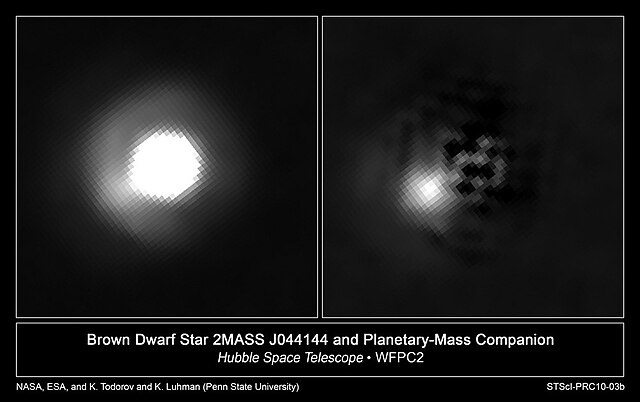Methods of detecting exoplanets
Any planet is an extremely faint light source compared to its parent star. For example, a star like the Sun is about a billion times as bright as the reflected light from any of the planets orbiting it. In addition to the intrinsic difficulty of detecting such a faint light source, the light from the parent star causes a glare that washes it out. For those reasons, very few of the exoplanets reported as of January 2024 have been observed directly, with even fewer being resolved from their host star.
Theoretical transiting exoplanet light curve. This image shows the transit depth (δ), transit duration (T), and ingress/egress duration (τ) of a transiting exoplanet relative to the position that the exoplanet is to the star.
This image shows the relative sizes of brown dwarfs and large planets.
Artist's impression of the pulsar PSR 1257+12's planetary system.
The Kepler Mission, A NASA mission which is able to detect extrasolar planets
An exoplanet or extrasolar planet is a planet outside the Solar System. The first possible evidence of an exoplanet was noted in 1917 but was not then recognized as such. The first confirmation of the detection occurred in 1992. A different planet, first detected in 1988, was confirmed in 2003. As of 1 May 2024, there are 5,662 confirmed exoplanets in 4,169 planetary systems, with 896 systems having more than one planet. The James Webb Space Telescope (JWST) is expected to discover more exoplanets, and to give more insight into their traits, such as their composition, environmental conditions, and potential for life.
Exoplanet HIP 65426b is the first discovered planet around star HIP 65426.
The three known planets of the star HR8799, as imaged by the Hale Telescope. The light from the central star was blanked out by a vector vortex coronagraph.
2MASS J044144 is a brown dwarf with a companion about 5–10 times the mass of Jupiter. It is not clear whether this companion object is a sub-brown dwarf or a planet.
Coronagraphic image of AB Pictoris showing a companion (bottom left), which is either a brown dwarf or a massive planet. The data were obtained on 16 March 2003 with NACO on the VLT, using a 1.4 arcsec occulting mask on top of AB Pictoris.








